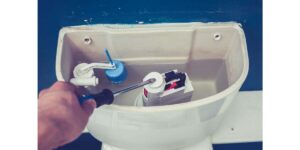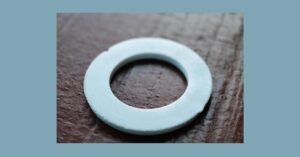Keeping a toilet bowl clean can be tedious, especially if you must scrub hard to remove stains and buildup.
However, several methods can help you clean your toilet bowl without scrubbing.
From using cleaning tablets to natural cleaners to chemical cleaners and specialized tools, there are many ways to maintain a sparkling clean and fresh-smelling toilet bowl.
This article will explore various techniques for cleaning a toilet bowl without scrubbing and provide ongoing maintenance and upkeep tips.
Using Automatic Toilet Cleaners
Using automatic toilet cleaners is easy and convenient to clean your toilet bowl without scrubbing.
These products come from a small tablet or disk in your toilet’s tank.
They typically contain cleaning agents, such as chlorine or hydrogen peroxide, released into the bowl with each flush.
Some automatic toilet cleaners also have a blue dye that helps to indicate when it’s time to replace the tablet.
One advantage of using automatic toilet cleaners is that they work continuously, so you don’t have to remember to clean your toilet bowl regularly manually.
They are easy to install and typically last for several weeks or months, depending on the product.
Prevent Dirt and Stains with an Automatic Cleaner
An automatic toilet cleaner can help to prevent dirt and stains from building up in your toilet bowl.
These products release cleaning agents into the bowl with each flush, helping break down and regularly removing stains and grime.
It can make it easier to clean your toilet bowl without frequent scrubbing.
Benefits of using an automatic cleaner:
- Convenience: An automatic cleaner works continuously, so you don’t have to remember to clean your toilet bowl regularly manually.
- Ease of use: They are easy to install and typically last several weeks or months, depending on the product.
- Variety of options: Different types of automatic cleaners are available in the market that caters to various cleaning needs, such as preventing hard water stains, cleaning rims, or killing germs and bacteria.
Different types of automatic cleaners available in the market:
- Tablet cleaners: These are small tablets placed inside your toilet tank. They typically contain chlorine or hydrogen peroxide, released into the bowl with each flush.
- Drop-in cleaners are similar to tablet cleaners but are dropped into the toilet bowl instead of in the tank.
- Rim Block: These are placed on the rim of the toilet bowl to clean the rim. They usually have a long-lasting effect and effectively prevent hard water stains.
How to install an automatic cleaner:
- First, locate the tank of your toilet and remove the lid.
- Place the cleaner in the tank according to the manufacturer’s instructions.
- Replace the lid and flush the toilet to activate the cleaner.
- Be sure to read the manufacturer’s instructions for the recommended usage time.
Following the manufacturer’s instructions and warnings is essential when installing and using automatic toilet cleaners.
Keep your Toilet Fresh with a Cleaning Tablet
A cleaning tablet is an easy and effective way to keep your toilet fresh and clean without scrubbing.
Small tablets or discs placed inside your toilet’s tank typically contain cleaning agents such as chlorine or hydrogen peroxide released into the bowl with each flush.
Let’s start by removing the lid from the tank and placing the tablet inside.
Some tablets come with a holder or container, so you should follow the instructions on how to put them.
Then replace the lid and flush your toilet as usual. Cleaning tablets typically last several weeks or months, depending on the product and usage.
Using Natural Cleaners
Use Vinegar Alone
To use vinegar to clean your toilet:
- Mix a cup of white vinegar with half a cup of baking soda.
- Pour the mixture into the toilet bowl, and use a toilet brush to gently scrub the bowl, paying extra attention to any areas with visible stains or grime.
- Allow the mixture to sit in the bowl for at least 30 minutes before flushing.
It will help to break down any buildup and stains, making them easier to remove.
Use White Vinegar and Warm Water
To use this combination to clean your toilet:
- Mix a cup of white vinegar with a gallon of warm water in a bucket or large container.
- Use a toilet or a scrub brush to apply the solution to the inside of the toilet bowl, including the rim, and scrub the bowl thoroughly, paying extra attention to any areas with visible stains or grime.
- Let the solution sit for at least 30 minutes before flushing the toilet.
Using Vinegar and Baking Soda
Using a combination of vinegar and baking soda is a popular and effective method for cleaning various surfaces, including toilet bowls.
The vinegar’s acidity helps break down and dissolve dirt, grime, and stains, while the baking soda acts as a mild abrasive to help scrub the buildup.
Together, the two ingredients create a powerful cleaning solution.
Mix half a cup of baking soda and white vinegar in a bowl to make a fizzy vinegar and baking soda cleaner for your toilet.
Once the mixture starts to fizz, it can be immediately poured into the toilet bowl, and use a toilet brush to gently scrub the bowl, paying extra attention to any areas with visible stains or grime.
Allow the mixture to sit in the bowl for at least 30 minutes before flushing.
This will help to break down any buildup and stains, making them easier to remove.
Try DIY Cleaning Bombs Made with Citric Acid and Baking Soda
DIY cleaning bombs made with citric acid and baking soda are popular and effective for cleaning toilet bowls.
These bombs are simple and can effectively replace store-bought cleaning products.
They work by using the acidity of citric acid to break down and dissolve stains and grime, while the baking soda acts as a mild abrasive that can help scrub the buildup.
To make DIY toilet bombs, you will need the following ingredients:
- One cup of baking soda
- 1/2 cup citric acid
- 3-4 tablespoons of water
- 15-20 drops of essential oils (such as tea tree, lemon, or eucalyptus) (optional)
- silicone molds (ice cube or bomb mold)
To make the toilet bombs:
- Mix the baking soda and citric acid in a bowl.
- Slowly add the water, using only enough to make the mixture moist and moldable.
- Add essential oils if you choose.
- Press the mixture into the silicone molds.
- Allow the bombs to dry for several hours or overnight.
Once the bombs are dry, you can use one bomb for each cleaning session by dropping it into the toilet bowl and allowing it to fizz and dissolve before brushing and flushing the toilet.
Using Baking Soda and Lemon Juice
To make a cleaning solution using baking soda and lemon juice, mix half a cup of baking soda with the juice of one lemon in a bowl.
Once the mixture is combined, you can use it to clean your toilet bowl by applying it to the inside, including the rim.
Scrub the bowl thoroughly, and pay extra attention to any areas with visible stains or grime.
Let the solution sit for at least 15-30 minutes before flushing the toilet.
This will help the solution to break down and dissolve any buildup and stains, making them easier to remove.
Using Baking Soda and Vinegar
To make a cleaning solution using baking soda and vinegar, mix half a cup of baking soda with a cup of white vinegar in a bowl.
Once the mixture starts to fizz, it can be applied to the inside of the toilet bowl, including the rim.
And then scrubbed with a toilet brush.
Using Baking Soda and Castile Soap
To make a cleaning solution using baking soda and castile soap:
- Mix a half cup of baking soda with a tablespoon of liquid castile soap in a bowl.
- Mix until it becomes a paste.
- Apply the paste to the inside of the toilet bowl, including the rim, and scrub the bowl thoroughly, paying extra attention to any areas with visible stains or grime.
- Let the solution sit for at least 15-30 minutes before flushing the toilet.
It is a gentle, eco-friendly solution yet still powerful enough to leave your toilet bowl clean and fresh.
Using Essential Oils for Freshness and Cleaning
Using essential oils for cleaning and adding freshness to your toilet can be a natural and effective way to enhance the cleaning process.
Essential oils can act as natural disinfectants and deodorizers, adding a pleasant fragrance to the bathroom.
Here are some essential oils that are good for cleaning:
- Tea tree oil: known for its antiseptic properties, it can help to kill germs and bacteria and eliminate odors
- Lemon oil: its fresh citrus scent can help to neutralize odors, and its acidity can help to break down stains
- Eucalyptus oil: it has antiseptic properties and can help to freshen the air and eliminate odors
- Peppermint oil: This oil has antiseptic properties, can help freshen the air, and can repel insects.
To use essential oils for cleaning and adding freshness to your toilet, add a few drops of your chosen oil to your cleaning solution or directly to the toilet bowl before cleaning.
You can also add a few drops of oil to a cotton ball or small piece of cloth and place it inside your toilet tank; this way, it will release a fresh scent every time you flush.
You can also use essential oils in a diffuser, creating a pleasant and natural scent in the bathroom.
It’s a good option to create a fresh and clean atmosphere in the bathroom without cleaning.
Using Bleach
Tackle Mold and Bacteria with Bleach
When using bleach to clean your toilet, taking safety precautions is essential.
Bleach is a strong chemical that can be harmful if not used properly.
Always wear gloves and protective eyewear when using bleach, and make sure the bathroom is well-ventilated.
Additionally, never mix bleach with other cleaning products, as this can produce toxic fumes.
To use bleach for cleaning your toilet:
- Add 1/2 cup of bleach to the toilet bowl and let it sit for 10-15 minutes.
- Use a toilet brush to scrub the bowl, paying extra attention to areas with visible stains, mold, or mildew.
- Before flushing, let it sit for another 5-10 minutes.
- Flush the toilet and rinse the bowl with clean water.
You must be careful when cleaning with bleach as it can discolor or corrode certain surfaces and harm inhaling.
Hydrogen Peroxide
Hydrogen peroxide is a popular and effective cleaning agent to tackle bacteria and stains in your toilet bowl.
Peroxide is a mild antiseptic that can kill germs, bacteria, and mold. It is also a natural whitener, removing stains and brightening surfaces.
To use hydrogen peroxide to clean your toilet:
- Add 1 cup of hydrogen peroxide to the toilet bowl and let it sit for 15-30 minutes.
- Use a toilet brush to scrub the bowl, paying extra attention to areas with visible stains, mold, or mildew.
- Before flushing, let it sit for another 5-10 minutes.
- Flush the toilet and rinse the bowl with clean water. You can also add some essential oils to it for a fresher scent.
Other Tips and Tricks
Use a Pumice Toilet Bowl Ring Remover
A Pumice toilet bowl ring remover is a tool that can be used to remove stains and buildup from the inside of a toilet bowl.
It’s a hard, abrasive, and non-toxic bar made of pumice, a volcanic rock formed from cooled lava.
The pumice material on the bar works by gently rubbing away the stains and buildup without damaging the porcelain surface of the toilet bowl.
Using Pumice toilet bowl ring remover is straightforward. Here’s how to use it:
- Wet the Pumice bar and the affected toilet bowl area with water.
- Hold the Pumice bar and rub it gently against the stains and buildup, using a circular motion.
- Keep rubbing the Pumice bar against the stains until they are removed.
- Use a toilet brush to scrub the bowl, then flush and rinse the toilet bowl with clean water.
Pumice toilet bowl ring remover can effectively remove stains and buildup from the toilet bowl.
It may require some elbow grease and multiple uses to remove tough stains completely.
Use a Toilet Plunger
A toilet plunger is not just a tool to unclog toilets; it can also be used to clean your toilet bowl.
The plunger’s rubber cup can scrub the bowl and remove stains.
Here’s how to use a toilet plunger for cleaning:
- Wet the rubber cup of the plunger with water.
- Put the rubber cup of the plunger over the drain of the toilet.
- Use the plunger to scrub the inside of the bowl, paying extra attention to areas with visible stains, mold, or mildew.
- Use a toilet brush to scrub the bowl, then flush and rinse the toilet bowl with clean water.
While a toilet plunger can be used to clean the toilet bowl, it’s less effective than other cleaning tools like a toilet brush or pumice stone.
It may not be as gentle on surfaces, and it’s not recommended to use it frequently as it can damage the porcelain.
It’s a good option to use as a supplementary cleaning tool, especially for hard-to-reach areas or tough stains.
Use an Automatic Toilet Cleaning System
An automatic toilet cleaning system is a device that can be installed in your toilet tank, and it dispenses cleaning solution into the toilet bowl every time you flush.
These systems come in different types, some can be affixed to the inside of the tank, and others can be placed in the water reservoir.
They also can be manual or automatic.
Here are the types of automatic toilet cleaning systems:
- Drop-in tablets: These are tablets that you drop into your toilet tank. They slowly dissolve, releasing cleaning solution into the bowl with every flush.
- Tank-mounted systems: These systems attach to the inside of your toilet tank and automatically release cleaning solutions into the bowl with every flush.
- Reservoir systems: These systems add a cleaning solution to the water reservoir, which is released into the bowl with every flush.
Installing and using an automatic toilet cleaning system is relatively straightforward:
- Follow the instructions that come with the system for installation.
- Once installed, fill the system with the appropriate cleaning solution per the manufacturer’s instructions.
- The system automatically releases the cleaning solution into the bowl with every flush.
- Depending on your system, you may need to refill the solution; check the instructions for guidance.
An automatic toilet cleaning system can be a convenient way to keep your toilet bowl clean and fresh.
It doesn’t require much effort, you have to install it, and it works automatically.
Following the manufacturer’s instructions is essential, as some systems may require regular maintenance.
It’s also important to regularly check the toilet bowl for stains, mold, and mildew and clean it as needed, even when using an automatic cleaning system.
Removing Rust or Lime Stains with Muriatic Acid
Muriatic acid, or hydrochloric acid, is a strong and effective cleaning agent.
This can remove rust and lime stains from the inside of a toilet bowl.
Muriatic acid works by dissolving mineral buildup and stains, making it a powerful tool for eliminating hard-to-clean stains.
Knowing that muriatic acid is highly corrosive and must be handled with extreme care is essential.
It would be best if you took several precautions when using it:
- Wear gloves, long sleeves, and eye protection
- Work in a well-ventilated area
- Never mix it with other cleaning agents, as it can create dangerous reactions.
- Never use it on surfaces other than porcelain, as it can cause damage
To use muriatic acid for cleaning your toilet, you can follow these steps:
- Dilute the acid per the manufacturer’s instructions, typically 1 part acid to 10 parts water.
- Pour the solution into the toilet bowl and let it sit for 15-20 minutes, depending on the severity of the stains.
- Use a toilet brush to scrub the bowl, paying extra attention to areas with visible stains, mold, or mildew.
- Flush the toilet and rinse the bowl with clean water.
It’s important to note that even though Muriatic acid can be very effective against rust and lime stains.
It should not be used as it can be harsh on surfaces.
Regular cleaning with a cleaning solution and brush are recommended to keep your toilet in top condition.
Always carefully check the label and manufacturer’s instructions, and never use more than recommended.
Install a Water Softener to Prevent Hard Water Stains
Hard water has high mineral content, specifically high levels of calcium and magnesium.
This can cause buildup and stains in your toilet bowl and other appliances and fixtures in your home.
Installing a water softener can help prevent hard water stains by removing these minerals from the water supply.
There are different types of water softeners available, including:
- Ion exchange: This softener uses resin beads to remove minerals from the water.
- Salt-free: This type of softener uses a process called “template-assisted crystallization” to change the minerals in the water so they cannot stick to surfaces.
- Reverse osmosis: This softener uses a membrane to filter out minerals and other impurities in the water.
To install a water softener, you will typically need to:
- Choose a unit located near a power source and the main water line.
- Install the unit according to the manufacturer’s instructions.
- Connect the unit to the main water line and a power source.
- Set the unit to the appropriate settings for your water supply.
To maintain a water softener, you will need to:
- Refill the unit with salt as needed.
- Check the unit regularly for any leaks or other issues.
- Have the unit serviced and cleaned as needed.
A water softener is a relatively easy solution to prevent hard water stains but can be costly to install and maintain.
Always follow the manufacturer’s instructions for your specific unit and consult a plumber if you need clarification on installation or troubleshooting issues.
Best Practices for Regular Maintenance
Importance of Regular Cleaning
Regular cleaning and maintenance are essential for keeping your toilet in good condition, preventing buildup and stains, and avoiding unpleasant odors.
Even if you use high-quality cleaner and cleaning tools, regular maintenance will help to keep your toilet bowl looking and smelling fresh.
Here are some tips for regular maintenance:
- Clean the toilet bowl regularly, at least once weekly, with a toilet brush and cleaning solution.
- Scrub under the rim, paying extra attention to areas with visible stains, mold, or mildew.
- Clean the exterior of the toilet, including the base, the tank, and the seat.
- Check for leaks and ensure all parts are tightened, and the toilet is securely in place.
- Check the water level of the tank and adjust it if necessary.
To keep the toilet bowl fresh between deep cleanings, you can:
- Use a freshener like a hanging deodorizer or drop-in toilet cleaner with a pleasant scent.
- Sprinkle baking soda in the bowl, then scrub it with a toilet brush. It will help absorb odors and keep your toilet smelling fresh.
- Place a small amount of vinegar in the bowl, let it sit for a few minutes, and then scrub and flush.
- Use an automatic cleaning tablet that releases cleaner and freshener with every flush.
Using appropriate cleaning solutions and tools helps prevent buildup and stains and reduce the need for harsher cleaning methods or chemicals.
It’s recommended to schedule deep cleaning sessions every 3-6 months to ensure that the toilet is in top condition and address any issues that may have been missed in the regular maintenance routine.
Conclusion
Keeping your toilet bowl clean without scrubbing may seem daunting, but with a little effort, you can easily maintain a clean and fresh-smelling toilet.
This article covered various methods for cleaning your toilet bowl without scrubbing, including using cleaning tablets, natural cleaners, and chemical cleaners.




